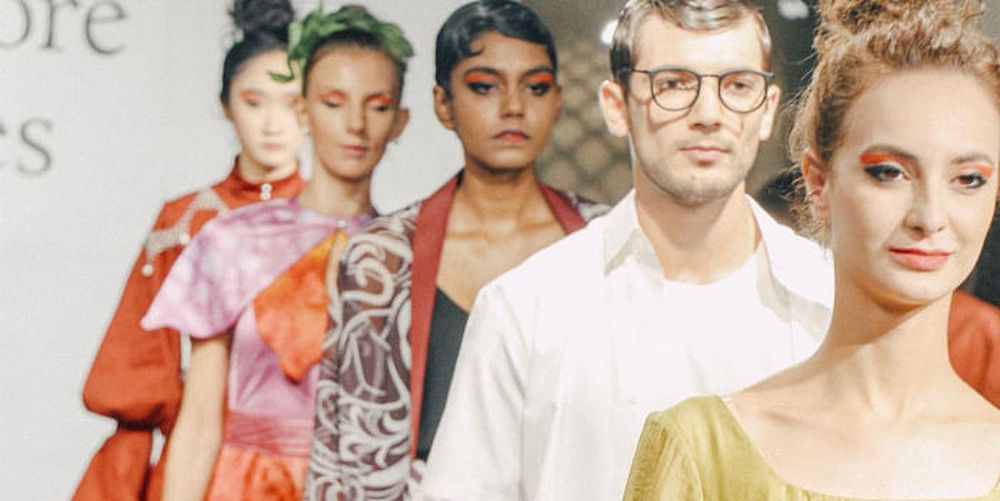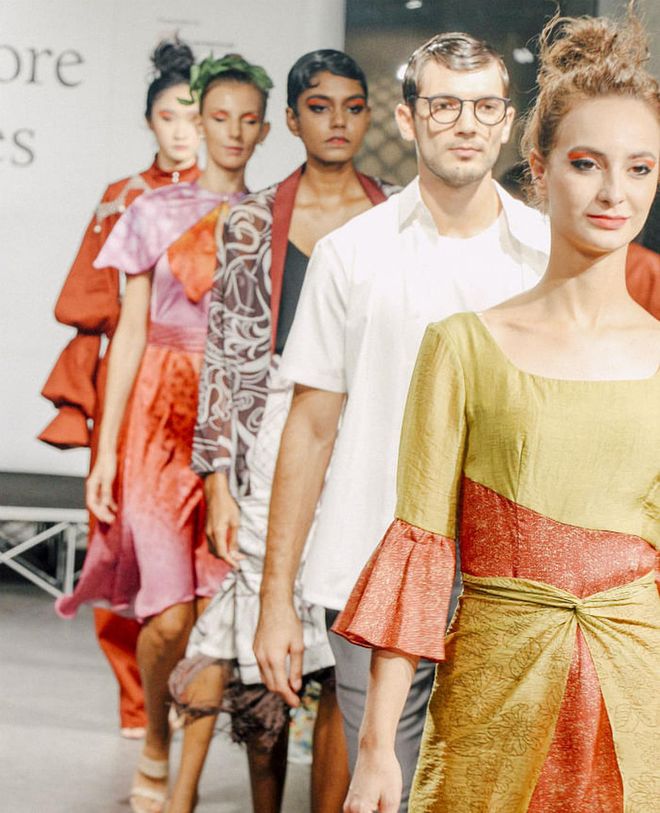Meet The 7 Designers Telling Singapore's Story With Fashion
These local talents have designed home-inspired collections for TaFF's Singapore Stories this year


Photo: Courtesy
Ah, good old Singapore - where piping hot chicken rice is always close, public transport is clean and efficient, and nearly everyone you meet shares a common tongue: Singlish. There are many other things that makes Singapore uniquely Singaporean, but is fashion one of them? To answer that question, Textile and Fashion Federation (TaFF) has brought back Singapore Stories for a second edition this year, centered on the theme of the Singapore Bicentennial: the 200th anniversary of Sir Stamford Raffles’ arrival.
With the goal of spotlighting and supporting homegrown fashion talent, 7 up-and-coming local brands have been handpicked to create collections inspired by our island city's rich heritage and the amalgamation of culture it holds. Coming from various walks of life, each designer has presented their own take on what Singaporean fashion means to them. Here's your first look at the collections - which will be available to shop for a month at Design Orchard. From 2nd – 4th August, you can also check out the pop-up stores showcasing the collections at Tencel Studio, Design orchard.
Related article: Design Orchard Champions Innovation & Sustainability With The Cocoon Space
CAYRA
What was the key inspiration behind your collection?
We were inspired by the Chetti Melaka, a group of Peranakan Indians whose mixed culture expresses the rich diversity of the country. The Chetti Melaka speak a creole that is mainly founded by Malay but also include elements of Tamil and the Hokkien dialect, while their cuisine has elements of Indian, Malay and Peranakan Chinese dishes. While men would wear traditional Malay clothing, women would dress like Peranakan Chinese.
Why did this inspire you?
We truly appreciate Singapore being a multiracial and multicultural country, and there is no other country like her. Unfortunately, with only two hundred Chitties recorded in Singapore, this culture is at risk of vanishing. We would like to bring awareness of the Chetti Melakas and preserve their practices.
What do you hope your collection will achieve?
We hope to nurture more fashion consumers who care about the culture and history in Singapore and who dress for a cause. Through this project, CAYRA hopes to inspire more Singaporeans to support young local brands who can help them create their own unique identity through fashion.
KANYEKA
What was the key inspiration behind your collection?
As I spent time reading about Singapore and sifting through pictures from down the ages, what stood out most was the fact that in the last two centuries, Singapore had progressed in a balanced and sustained manner, on account of its richest resource, its people! I designed a collection to show Singapore's growth story, told through the lens of its people. I also designed the 'Singapore Sling' bag, a fun take on the world-famous, homegrown cocktail drink.
Why did this inspire you?
This was my tribute to Singapore's multi-cultural society. A warm, inclusive, community that speaks many different languages, but yet has 'one united voice'.
What do you hope your collection will achieve?
I always aim to make products that are stylish and functional rather than gimmicky, souvenir like merchandise. With this collection, I hope to have made classic, Singapore inspired fashion completely wearable round the year rather than only during the run-up to National Day. After all, since pride and love for one's nation isn't seasonal, why should fashion based on that sentiment be?
Related article: A To Z Of Singapore Fashion Designers
JOAN GUO
What was the key inspiration behind your collection?
My inspiration comes from Lion Dance and Peranakan art. Deriving aesthetics from both art forms, the textiles prints in the collection draws a connection between the spiral flames in Lion Dance and the art nouveau symmetrical curved lines in Peranakan tiles. Relaxed, tailored silhouettes were inspired by baju kurung and wushu uniforms.
Why did this inspire you?
I wanted to focus on fading Singaporean art forms, and Lion dance is one that deserves better preservation. I remember that in my younger years, my family loved watching lion dancing competitions. The absence of these competitions became loud in my mind. While researching about lion dance, I chanced upon an opportunity to talk to Kong Chow Clan Association, located in Chinatown. Their preservation and collection of cultural artifacts in the clan is impressive, so much so that lion dance troops from China often visit to learn from them and also to enjoy the most comprehensive collection of lion heads in the world. The visit to the clan and the level of craft intricacy of the lion heads cemented my desire to design a collection about lion dance.
What do you hope your collection will achieve?
I hope this collection can provide conversational pieces that give a story for the wearer to share, and inspire consumers value provenance and the fading art forms of Singapore.
CYC
What was the key inspiration behind your collection?
I was reading Mr. Lee Kuan Yew’s ‘Hard Truths To Keep Singapore Going’, and I came across the chapter titled ‘Singapore is an 80-storey building on Marshy land’. That sentence conjures up images of Singapore as an improbable, leading cosmopolitan city built upon a Mangrove swamp, which I found interesting and surreal. I came up with 2 concept prints - Mangrove Forest and Concrete Jungle, and we styled them in a 1970's Singapore style. If you look at archival pictures of 1970s Singapore, you see a lot of men wearing loose-fitting white singlets and white short sleeved shirts.
Why did this inspire you?
I found it be relevant to the ‘Bicentennial’ theme. While one print celebrates Singapore's 'mangrove swamp' past, the other print celebrates Singapore's modern, awe-inspiring architecture, like the MBS, Jewel and Singapore Flyer. It also features a poem that serves as a critique on commercial success and colonialism.
What do you hope your collection will achieve?
I hope that my designs initiative conversation about what constitutes Singapore's identity. Are we our beautiful buildings? Are we a mangrove swamp? Are we a product of colonialists? How does commercialism impact our identity?
ESTHER TAY
What was the key inspiration behind your collection?
Singapore’s rich heritage and culture, from a little village to a financial innovation hub. I want to recapture the East and the West and make it work, the west for its colour, for its look, its resources. The East for its textiles, prints and patterns.
What do you hope your collection will achieve?
I hope the piece's East-meets-West look generates an international appeal for Singaporean fashion.
KAYLOO
What was the key inspiration behind your collection?
My collection, titled “Our Fore-mothers”, is dedicated to the women who built up Singapore. The collection comprises nine prints which show some of the work women in the early days of Singapore carried out every single day to help our society function and progress. All prints are depicted with a woman’s hand(s) to represent her actions, care and presence.
Why did this inspire you?
When looking at Singapore’s history, we often reflect on our forefathers, but it is important not to overlook the efforts of women in Singapore in supporting our households and being in the workforce, where they made up a critical part of the early foundation of Singapore. In conversations with my grandmother, mum and aunts, they recounted past memories of having to do all the sewing for their family with an old-fashioned sewing machine (which I used to play with when I was young), washing clothes on a washing board, and putting children to sleep with a sarong hanging from a ceiling. It made me realise how little I knew about what women in the past used to do.
What do you hope your collection will achieve?
I hope that my collection can be used as a medium to give women the recognition they deserve for what used to do to support their families.
WEEKEND SUNDRIES
What was the key inspiration behind your collection?
I was inspired by the local childbood game Zero Point comprising of a simple prop made by linking up thin rubber bands to form a long elastic rope. The rules challenge the players to clear each level with higher jumps. The capsule is suggestive of Singapore’s resourcefulness, mobility and optimism.
Why did this inspire you?
My fondest memories of growing up are filled with these playtime activities and adventures with my cousins and neighbourhood kids, running around outdoors and being resourceful with what we could find.
What do you hope your collection will achieve?
Positivity, empathy and a sense of wonderment.
As an added bonus, the pieces made for Singapore Stories are produced using sustainable fabrics by Lenzing, made from renewable raw material wood with environmentally friendly technologies.
The collections will be available at the retail space on Level 1 in Design Orchard for the month of August.
Related article: 10 Local Designers Tell Us Why They Love Singapore